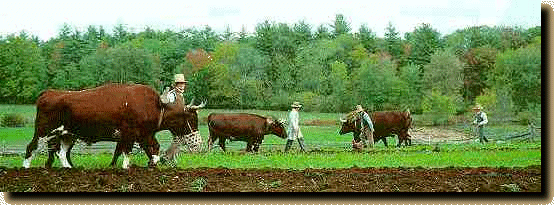
Farm interpreters at Old Sturbridge Village work with animals every day. Most of the livestock have been "backbred" to look like the farm animals of the early nineteenth century. In effect, they wear their own "costumes."
In the early nineteenth century, oxen were the primary draft animals on New England farms. Though slower than horses, oxen were more powerful. They were also much cheaper to obtain and maintain, and had value as beef.
Early New England Fall Harvest. for farm families, meant harvesting, preserving, and storing food were a year-long endeavor that began with spring planting and dairying reached its peak with the late fall harvest of root vegetables and pumpkins.
The seasonality of agricultural life has always been a major theme at Old Sturbridge Village. "Early 19th-century families would begin preparing for the next season in advance. The freshening of cows in the spring provided an abundance of milk for processing. The milk fat or cream was converted into an important commodity --butter. When properly made and stored, butter would keep well through the winter.
Dairying turned to cheese making, when the weather turned sultry and warm. Visitors to Old Sturbridge Village often ask how to store cheese, they are informed by the Village staff, that they should think of it as 'cheese is a way to store milk.' Hard cheeses were made to provide nutrition to the family and were easily traded and sold for income.
[Home] [Norman Rockwell Museum] [Rockwell Self Portrait] [Sturbridge Village] [Dickinson Homestead] [Dickinson Portrait] [Springfield Armory] [Stanley Park] [The Titanic] [The Titanic Historical Museum] [Maude Tait] [Connecticut Trolley Museum] [Dr. Seuss]